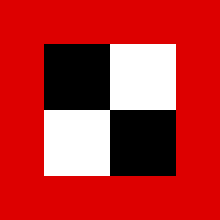11th Army (German Empire)
The 11th Army (German: 11. Armee / Armeeoberkommando 11 / A.O.K. 11) was an army level command of the German Army in World War I. It was formed in March 1915 in Kassel originally to serve on the Western Front but was transported to Galicia for service on the Eastern Front. The army was dissolved on 8 September 1915,[1] but reformed on 23 September 1915 for the Serbian Campaign. It was finally dissolved on 7 January 1919.[2]
| 11. Armee 11th Army | |
|---|---|
 Flag of the Staff of an Armee Oberkommando (1871–1918) | |
| Active | 9 March 1915 – 8 September 1915 23 September 1915 – 7 January 1919 |
| Country | |
| Type | Army |
| Engagements | World War I
|
| Insignia | |
| Abbreviation | A.O.K. 11 |
History
The 11th Army was formed in early 1915. It briefly fought on the Western Front during the Battle of Ypres, holding the line against the Allied attack. On 22 April, it was transferred and placed with the Austrian 4th Army under Mackensen's command, behind the Gorlice–Tarnow gap, south of the Vistula River. In July 1915, the 11th Army advanced into Russian territory in a general German offensive. The 11th Army was dissolved on 8 September 1915.
On 23 September 1915 a new 11th Army was created for the Serbian Campaign under command of Max von Gallwitz. It was composed of the III Corps, the IV Reserve Corps and the X Reserve Corps. After the retreat of Serbian army, the 11th Army remained on the Salonika Front in support of the Bulgarian Army. During its time on the front the army gradually became more and more composed of Bulgarian divisions. By the time of the Vardar Offensive in September 1918, The 11th German Army consisted almost fully of Bulgarian soldiers commanded by German officers.[3]
The headquarters of the Army was situated in Veles on 31 January 1916, moved to Prilep on 5 October 1916 until the retreat to Hungary in September 1918.
Commanders
11th Army had the following commanders until absorbed by Heeresgruppe Mackensen on 8 September 1915:[4]
| From | Commander | Previously | Subsequently, |
|---|---|---|---|
| 9 March 1915 until 27 March 1915 | General der Infanterie Max von Fabeck | XIII Corps | 1st Army |
| 16 April 1915 | Generaloberst August von Mackensen | 9th Army | Heeresgruppe Mackensen concurrently from 27 April 1915 |
| 22 June 1915 | Generalfeldmarschall August von Mackensen |
The "new" 11th Army had the following commanders:[5]
| From | Commander | Previously | Subsequently, |
|---|---|---|---|
| 23 September 1915 | General der Artillerie Max von Gallwitz | 12th Army | Attack Group West – Verdun |
| 16 April 1916 acting until 23 July 1916 | General der Infanterie Arnold von Winckler | IV Reserve Corps concurrently until 24 July 1916 | I Corps |
| 5 June 1917 | General der Infanterie Kuno von Steuben | XVIII Reserve Corps | Retired status[6] |
Glossary
- Armee-Abteilung or Army Detachment in the sense of "something detached from an Army". It is not under the command of an Army so is in itself a small Army.[7]
- Armee-Gruppe or Army Group in the sense of a group within an Army and under its command, generally formed as a temporary measure for a specific task.
- Heeresgruppe or Army Group in the sense of a number of armies under a single commander.
See also
- 11th Army (Wehrmacht) for the equivalent formation in World War II
References
- Headquarters used to form Heeresgruppe Mackensen.
- Cron 2002, p. 81
- Korsun 1939, p. 95.
- Cron 2002, p. 397
- Cron 2002, p. 397
- The Prussian Machine Accessed: 6 February 2012
- Cron 2002, p. 84
Bibliography
- Cron, Hermann (2002) [1937]. Imperial German Army 1914–18: Organisation, Structure, Orders-of-Battle. Helion & Co. ISBN 1-874622-70-1.CS1 maint: ref=harv (link)
- DiNardo, Richard L. (2015). Invasion: The Conquest of Serbia, 1915. Santa Barbara: Praeger.CS1 maint: ref=harv (link)
- Ellis, John; Cox, Michael (1993). The World War I Databook. Aurum Press. ISBN 1-85410-766-6.CS1 maint: ref=harv (link)
- Korsun, Nikolay (1939). Балканский фронт мировой войны 1914–1918 гг [Balkan Front of the World War 1914–1918] (in Russian). Moscow: Boenizdat. OCLC 7970969.CS1 maint: ref=harv (link)